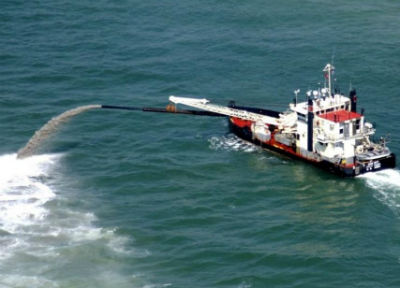RALEIGH – Small jetties, called terminal groins, could be built at all the inlets along the N.C. coast, under a bill that a state Senate committee passed yesterday, and state taxpayers could be asked to pay for all of them.
The bill lifts the cap of four groins that was set in a bill that the N.C. General Assembly passed in 2011. It also removes or weakens all the environment safeguards and the prohibitions on the use of state taxpayer money contained in the two-year-old legislation.
Supporter Spotlight
“This essentially guts the compromise bill on groins that was carefully crafted after much debate in 2011,” noted Todd Miller, the executive director of the N.C. Coastal Federation. “That was an attempt at a responsible piece of legislation. This new bill removes all accountability. It allows these damaging structures to be built anywhere and with no regard for who will pay for them or what they might do to public beaches.”
 Sen. Bill Rabon |
Sen. Bill Rabon, R-Brunswick, introduced the groin provisions at yesterday’s meeting of the Senate Agriculture, Environment and Natural Resources Committee. He had inserted them into a new version of his Coastal Policies Act of 2013. The committee passed the substitute bill. Its next stop is the Senate Finance Committee today, and the Senate is likely to vote on it this week.
Terminal groins, jetties, seawalls and other types of hard structures to control erosion had been banned on the state’s beaches since the 1980s because of the damage they can do to adjoining beaches. The 2011 bill allowed the first exceptions to the ban.
Rabon’s bill took many observers by surprise and drew a sharp reaction among longtime opponents of hardened structures on the coast.
“I’m very concerned,” said Sen. Ellie Kinnaird, D-Chapel Hill. “We have a beautiful coast and I don’t think it will beautiful after this. We know from testimony last time that you may put a groin in, but your neighbor may suffer greatly. I’m very concerned this is happening I think it is a betrayal of everything that was agreed to if groins were allowed.”
Supporter Spotlight
Rob Lamme, a lobbyist for the federation, spoke against the changes at the committee meeting, citing disagreements with both the environmental oversight changes and the implication for local taxpayers.
He said while the federation has long been opposed to the use of groins, the compromise legislation hammered out in 2011 had strong protections in both areas. “This bill raises many implications and many concerns, not just on the conservation side but also on the economic and tax implications of starting to put really expensive structures on our coast,” he said.
Rabon defended the bill saying if the groins could reduce the amount of inlet dredging they could save taxpayers money in the long run.
History seems to say otherwise because terminal groins, unlike jetties, are too short to stabilize channels and keep them from shoaling. A groin was built on Pea Island on the Outer Banks in the early 1990s to protect N.C. 12 on the south side of the Herbert C. Bonner Bridge. Shoaling of adjacent Oregon Inlet has worsened dramatically since then, and dredging hasn’t been able to keep a reliable navigation channel through the inlet open. The Army Corps of Engineers has to dredge Beaufort Inlet in Carteret County every few years despite a terminal groin at Fort Macon State Park on the west side of the inlet.
Rabon said the four pilot projects — Holden Beach, Ocean Isle, Bald Head Isle and Figure Eight Island — are under way and it is time to move forward on more.
“It takes quite a bit of time to get this in place and when your inlet is filling or when your front yard is washing away you don’t have a lot of time,” he said. “No one on this committee would decry the fire truck for running down the street to put out the fire, but I see people in this body constantly decrying trying to save the house that is washing away. It makes absolutely no sense to me. I live where houses wash away.”
Miller noted that all of the projects are still undergoing environmental review by the Army Corps of Engineer. None, he said, has been permitted. “It makes little sense to remove all safeguards before we know what kind of damage they can do and what requirements are needed to protect our beaches and the taxpayer’s pocketbook,” Miller said.
 Proponents of loosening restriction on terminal groin say more structures along the coast will lessen the need for dredging. |
Rabon’s bill drops language in the 2011 bill that requires that the groin be built if applicants demonstrate structures or infrastructure “are imminently threatened by erosion” and only if other measures, including relocating structures, are impractical. Under the new bill, alternatives are not required to be considered and applicants have to prove that structures or infrastructure are merely threatened by erosion.
Geoff Gisler, an attorney with the Southern Environmental Law Center who has been following the groin permitting changes, said the effect of the new bill would likely reduce environmental oversight of the projects in part because it lowers the threshold from “imminently threatened” to “threatened” and because it weakens requirements in a required inlet management plan, the chief method for follow through to make sure the structures are working as planned. The bill sets out new limits on what the management plan can contain and explicitly says consideration of sea-level rise can’t be required.
“This significantly reduces the analysis of what’s going to happen and the monitoring required,” Gisler said.
Giving applicants an out on sea-level rise ignores the science, he said. “We know that this is going to be a major player in the makeup of our coastal environment.”
As troubling, Gisler said, are provisions in the bill dropping financial assurance requirements on local government. The bill would lift restrictions on how local governments can finance groin projects allowing bonds and other financing options that do not require a local referendum, restrictions that were put in place in 2011, Gisler said, were put there so the public could have a voice in the process.
State taxpayer money could also be used without a vote by the legislature, which is now required.
Under the bill, the state also would no longer require groin applicants to provide financial assurances that they can cover the cost of any damage to public or private properties or for their long term maintenance as is now required.
The result, Gisler said, is that local governments could pursue the projects without being fully aware of the liability. He pointed to a study by the state’s Coastal Resources Commission that notes that terminal groins can cause damage and erosion.
“The idea that terminal groins have an adverse effect is not pulled out of the blue,” Gisler said.
In addition to the changes in the rules, Gisler said, lifting the four project cap and effectively allowing an unlimited number of groins could open the door to North Carolina’s shore resembling the armored coastlines elsewhere.
“What’s been demonstrated time and time again,” Gisler said, “is if you have one, you have many.







